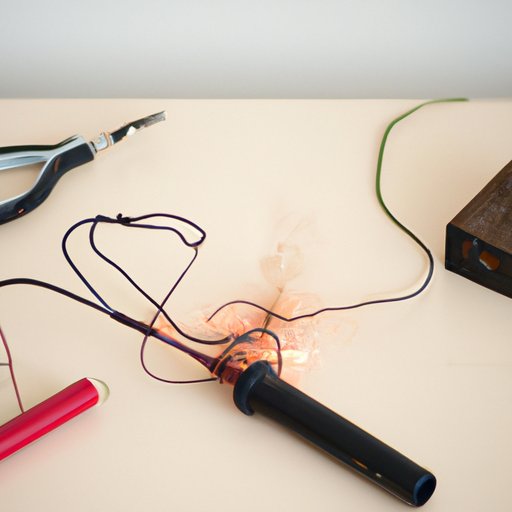I. Introduction
Have you ever wanted to repair a broken electronic device or build your own circuit board? Knowing how to solder is an essential skill for any DIY electronics enthusiast. Soldering involves melting a metal alloy to join two metal surfaces together and is commonly used in electronics assembly and repair. In this article, we’ll provide a comprehensive guide to help beginners get started with soldering and explore the various tools, techniques, and safety precautions involved.
II. Writing a step-by-step guide
Before we dive into the actual process of soldering, it’s important to familiarize yourself with the essential tools and materials you’ll need. The basics include a soldering iron, solder, a soldering stand, and a damp sponge. You’ll also need wire cutters, pliers, and a helping hand tool to hold the components in place while soldering. Once you have your tools, you can follow these steps to prepare for soldering:
- Set up your workspace in a well-lit, well-ventilated area.
- Organize your tools and materials for easy access.
- Place the soldering stand on a non-flammable surface.
- Plug in the soldering iron and allow it to heat up for a few minutes.
- Clean the soldering iron tip with a damp sponge to remove any debris or oxidation.
Now that you’re ready to start soldering, follow these steps:
- Hold the component in place with the helping hand tool.
- Touch the soldering iron to the joint where the two components meet.
- Once the joint is hot, touch the solder wire to the joint.
- Allow the solder to flow onto the joint and create a solid bond between the components.
- Remove the soldering iron and allow the joint to cool before moving on to the next one.
While soldering is a relatively straightforward process, there are a few common problems that people encounter:
- Cold joints occur when the solder doesn’t melt completely and doesn’t form a good bond. To fix this, reheat the joint and add more solder.
- Excessive heat can damage the components or lead to burnt solder. Be careful not to overheat the joint, and use a soldering iron with adjustable temperature settings if possible.
- Bad connections occur when there’s too much solder or the solder doesn’t flow evenly. Use a solder wick or pump to remove excess solder and start again.
III. Showcasing different soldering techniques
There are several different types of soldering techniques to consider depending on the project you’re working on. The most common methods include through-hole, surface mount, and non-plated through-hole (NPTH) soldering.
Through-hole soldering involves inserting a component lead into a drilled hole on the printed circuit board and soldering it in place. This method is best suited for larger components and is commonly used in audio and power supply circuits.
Surface mount soldering involves placing the component directly onto the surface of the board and soldering it in place. This method is ideal for smaller components, as it takes up less space on the board and allows for more dense circuit designs.
NPTH soldering involves soldering wires directly to non-plated holes in the board instead of using a through-hole component. This method is typically used for specialized applications where a non-plated connection is required.
To help you better understand these techniques, we’ve included some visual aids:

IV. Discussing safety precautions
It’s important to prioritize safety when soldering to avoid injury or damage to your components. Here are some general safety precautions to follow:
- Wear safety glasses to protect your eyes from flying debris.
- Work in a well-ventilated area to prevent inhaling fumes.
- Avoid touching the hot soldering iron and use a heat-resistant mat or stand to prevent burns.
- Always unplug the soldering iron when not in use.
Additional precautions may be necessary depending on the specific project you’re working on. For example, if you’re soldering wires to a battery, be sure to disconnect the battery first to avoid electric shock.
V. Showcasing product reviews
If you’re just getting started with soldering, it can be overwhelming to decide which tools and accessories to invest in. To help you out, we’ve put together some product reviews of essential soldering tools:
Soldering iron: The Weller SP40NKUS is a popular entry-level soldering iron that heats up quickly and has adjustable temperature settings. However, some users have reported that the tip can wear out quickly.
Solder: Kester 44 Rosin Core Solder is a reliable option that produces a strong bond and is easy to work with. However, some users have reported that it can create excessive smoke.
Soldering stand: The Aven 17542 Soldering Stand is a sturdy stand that can hold multiple tools and accessories. However, some users have reported that the sponge holder can be difficult to remove.
VI. Offering project ideas
Now that you have the tools and skills to start soldering, it’s time to put them to use! Here are a few beginner-friendly project ideas:
DIY flashlight: Use a breadboard to build a simple flashlight that’s powered by batteries.
Repair a headphone jack: Fix a broken headphone jack by soldering the wires back onto the connector.
DIY guitar pedal: Build your own distortion pedal using a printed circuit board and through-hole soldering.
For full instructions and step-by-step guides for these projects and more, check out some of the many tutorials available online.
VII. Conclusion
Soldering is an essential skill for anyone interested in DIY electronics. With the proper tools, techniques, and safety precautions, you can confidently take on any soldering project. Whether you’re repairing a broken device or building your own circuit, the possibilities are endless.
